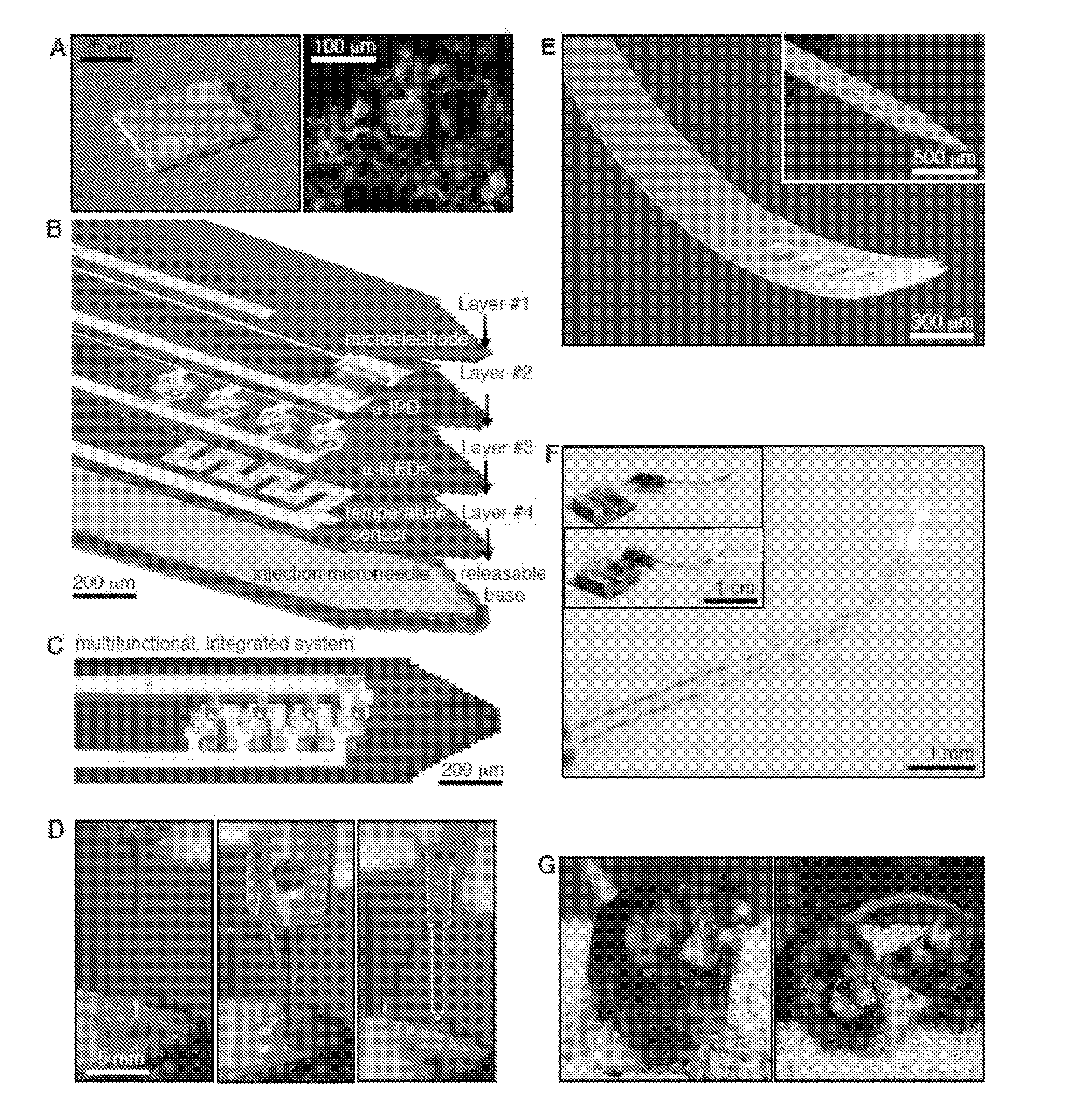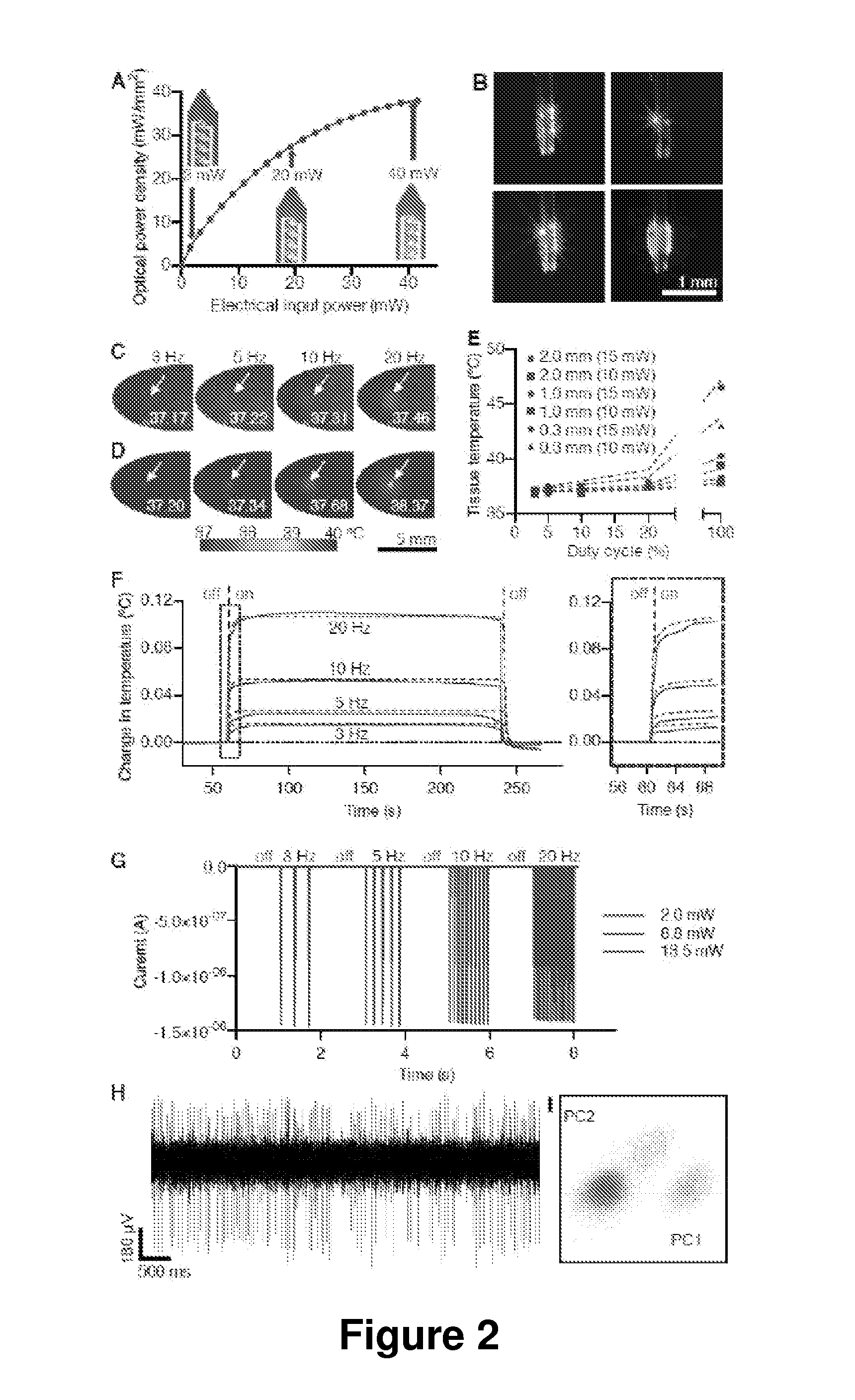Injectable and implantable cellular-scale electronic devices
a technology of electronic devices and cellular scales, applied in the field of biological tissue implantation, can solve problems such as heightened risk of adverse events, and achieve the effect of precise monitoring and control of biologic function
- Summary
- Abstract
- Description
- Claims
- Application Information
AI Technical Summary
Benefits of technology
Problems solved by technology
Method used
Image
Examples
example 1
Injectable, Cellular-Scale Optoelectronics with Applications for Wireless Optogenetics
[0189]Successful integration of advanced semiconductor devices with biological systems will accelerate basic scientific discoveries and their translation into clinical technologies. In neuroscience generally, and in optogenetics in particular, an ability to insert light sources, detectors, sensors and other components into precise locations of the deep brain could yield versatile and important capabilities. Here, we introduce an injectable class of cellular-scale optoelectronics that offers such features, with examples of unmatched operational modes in optogenetics, including completely wireless and programmed complex behavioral control over freely moving animals. The ability of these ultrathin, mechanically compliant, biocompatible devices to afford minimally invasive operation in the soft tissues of the mammalian brain foreshadow applications in other organ systems, with potential for broad utili...
example 2
Methods of Making and Using Injectable Cellular-Scale Optoelectronics
[0202]Preparation of μ-ILEDs: Fabrication begins with epitaxially grown GaN on a sapphire wafer (500 μm thick double polished sapphire with 2″ diameter, Cermet Inc.). The GaN stack layers consisted of undoped GaN (3.8 μm), n-type GaN (2 μm), spacer (0.4 μm), MQW (0.14 μm), and p-type GaN (0.2 μm). Residual metal ions and GaN oxide on the surface were removed by rinsing with diluted HCl (33%). L-shaped current spreading layers of Ni (15 nm) and Au (15 nm) were formed by sputter deposition (AJA ATC 2000), followed by annealing at 500° C. for 5 min in an oxygen and nitrogen atmosphere to form an ohmic contact. After exposing n-type regions defined using photolithography (40×40 μm2 recessive square with thick AZ 2035, Microchem Inc) and etched using chorine based inductively coupled plasma reactive ion etching (ICP RIE, Plasmatherm, SLR-770), both n- and p-contact pads, each 25×25 μm2 in dimension, of 15 nm of Cr and 3...
example 3
Implanted Device for Optical Interfacing with the Sciatic Nerve
[0242]FIG. 31. Implantable or surface mounted biomedical device having printed LEDs that are useful for optogenetic applications. FIGS. 32-33 show the device implanted in a mouse for interfacing with the sciatic nerve. As desired, any other nerve location may be interfaced, such as for optogentic studies or applications. Optionally, the mouse may be transformed to express a protein, channel, or other material that is sensitive to light. A light-responsive protein channel is particularly useful in optogenic applications, such as channelrhodopsins to excite neurons, halorhodopsin for silencing and fungal opsins and enhanced bacteriorhodopsin for inhibiting neurons, including in freely moving mammals.
[0243]In FIG. 32 the devices have been implanted in male wild-type Swiss-Webster infected with a herpes simplex 1 viral construct expressing the optogenetic channel ChR2 under the control of the CMV promoter. The sciatic nerve ...
PUM
 Login to View More
Login to View More Abstract
Description
Claims
Application Information
 Login to View More
Login to View More - R&D
- Intellectual Property
- Life Sciences
- Materials
- Tech Scout
- Unparalleled Data Quality
- Higher Quality Content
- 60% Fewer Hallucinations
Browse by: Latest US Patents, China's latest patents, Technical Efficacy Thesaurus, Application Domain, Technology Topic, Popular Technical Reports.
© 2025 PatSnap. All rights reserved.Legal|Privacy policy|Modern Slavery Act Transparency Statement|Sitemap|About US| Contact US: help@patsnap.com



